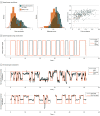Computational Methods to Measure Patterns of Gaze in Toddlers With Autism Spectrum Disorder
- PMID: 33900383
- PMCID: PMC8077044
- DOI: 10.1001/jamapediatrics.2021.0530
Computational Methods to Measure Patterns of Gaze in Toddlers With Autism Spectrum Disorder
Abstract
Importance: Atypical eye gaze is an early-emerging symptom of autism spectrum disorder (ASD) and holds promise for autism screening. Current eye-tracking methods are expensive and require special equipment and calibration. There is a need for scalable, feasible methods for measuring eye gaze.
Objective: Using computational methods based on computer vision analysis, we evaluated whether an app deployed on an iPhone or iPad that displayed strategically designed brief movies could elicit and quantify differences in eye-gaze patterns of toddlers with ASD vs typical development.
Design, setting, and participants: A prospective study in pediatric primary care clinics was conducted from December 2018 to March 2020, comparing toddlers with and without ASD. Caregivers of 1564 toddlers were invited to participate during a well-child visit. A total of 993 toddlers (63%) completed study measures. Enrollment criteria were aged 16 to 38 months, healthy, English- or Spanish-speaking caregiver, and toddler able to sit and view the app. Participants were screened with the Modified Checklist for Autism in Toddlers-Revised With Follow-up during routine care. Children were referred by their pediatrician for diagnostic evaluation based on results of the checklist or if the caregiver or pediatrician was concerned. Forty toddlers subsequently were diagnosed with ASD.
Exposures: A mobile app displayed on a smartphone or tablet.
Main outcomes and measures: Computer vision analysis quantified eye-gaze patterns elicited by the app, which were compared between toddlers with ASD vs typical development.
Results: Mean age of the sample was 21.1 months (range, 17.1-36.9 months), and 50.6% were boys, 59.8% White individuals, 16.5% Black individuals, 23.7% other race, and 16.9% Hispanic/Latino individuals. Distinctive eye-gaze patterns were detected in toddlers with ASD, characterized by reduced gaze to social stimuli and to salient social moments during the movies, and previously unknown deficits in coordination of gaze with speech sounds. The area under the receiver operating characteristic curve discriminating ASD vs non-ASD using multiple gaze features was 0.90 (95% CI, 0.82-0.97).
Conclusions and relevance: The app reliably measured both known and new gaze biomarkers that distinguished toddlers with ASD vs typical development. These novel results may have potential for developing scalable autism screening tools, exportable to natural settings, and enabling data sets amenable to machine learning.
Conflict of interest statement
Figures






